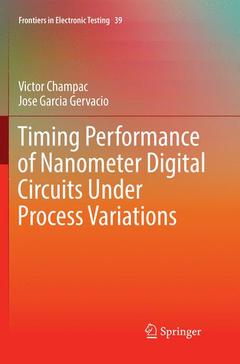Description
Timing Performance of Nanometer Digital Circuits Under Process Variations, Softcover reprint of the original 1st ed. 2018
Frontiers in Electronic Testing Series, Vol. 39
Authors: Champac Victor, Garcia Gervacio Jose
Language: English
Subjects for Timing Performance of Nanometer Digital Circuits Under...:
126.59 €
In Print (Delivery period: 15 days).
Add to cartPublication date: 01-2019
Support: Print on demand
126.59 €
In Print (Delivery period: 15 days).
Add to cartPublication date: 04-2018
Support: Print on demand
Description
/li>Contents
/li>Biography
/li>Comment
/li>
Victor Champac received the Electrical Engineering Degree in 1987 from the Autonomous University of Nuevo Leon, Mexico. He received the Ph.D. degree in 1993 from the Polytechnic University of Catalonia (UPC), Spain. From 1988 to 1993 he was Associate Professor at the Electronic Engineering Department of the UPC. In 1993 he joined the National Institute for Astrophysics, Optics and Electronics (INAOE) in Mexico where he is Titular Professor. He made sabbatical in 2001-2002 at Motorola and in 2010-2011 at the University of California (UCSD). Dr. Champac was a co-founder of the Test Technology Technical Council-Latin America of IEEE Computer Society. He was co-General Chair of the 2nd, 9th, 13th and 16th IEEE Latin-American Test Workshop (now Latin-American Test Symposium). He has also served as Guest Editor of the Journal of Electronics Testing, Springer. He is member of the Editorial Board of Journal of Electronic Testing (JETTA). He is a Senior member of the IEEE and the National Research System (SNI) in Mexico. He has served as program and organizing committee member of several international conferences. Dr. Champac received the best paper award of the IEEE Latin American Test Workshop in 2008. He has published more than 120 papers in international journals and conferences. His research lines include: circuit design under process variations, aging reliable circuit design, defect modeling in leading technologies, and development of new test strategies.
Jose Garcia Gervacio received the Electronics Engineering Degree in 1987 from the Technological Institute of Celaya, Mexico. He received the Master and Ph.D. degree in 2003 and 2009, respectively, from the National Institute for Astrophysics, Optics, and Electronics (INAOE), Mexico. From 2010 to 2011 he was an assistant professor at INAOE. From 2011 to 2013 he occupied a postdoctoral position in the Research center in Micro and Nanotechnology (MICRONA) of the Un
Describes in detail the digital design of integrated circuit under process variations with a focus on design-time understanding and optimization
Follows a step-by-step sequence in methodology, going from logic gates to logic paths to circuit level, in order to explain the behavior of process variations at the different levels of abstraction
Presents novel design issues for FinFET based digital circuits
Provides step-by-step examples of quantitative estimation of the timing performance of logic cells and logic paths, as well as a comparison with Spice simulation results




